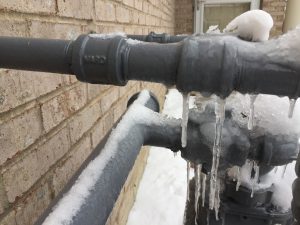Avoiding Frozen Plumbing in Cold Weather: Essential Advice
Avoiding Frozen Plumbing in Cold Weather: Essential Advice
Blog Article
Have you been interested in know-how on Winter Plumbing Precautions: Preventing Frozen Pipes?

Winter can wreak havoc on your pipes, specifically by freezing pipes. Below's how to avoid it from occurring and what to do if it does.
Intro
As temperatures drop, the danger of icy pipes rises, potentially bring about costly repair services and water damage. Comprehending how to avoid icy pipes is vital for homeowners in cold environments.
Understanding Frozen Pipes
What triggers pipelines to freeze?
Pipes ice up when revealed to temperature levels listed below 32 ° F (0 ° C) for expanded durations. As water inside the pipelines freezes, it broadens, taxing the pipeline wall surfaces and potentially causing them to break.
Risks and damages
Frozen pipelines can bring about water supply interruptions, residential or commercial property damages, and pricey fixings. Ruptured pipelines can flooding homes and create substantial structural damages.
Indications of Frozen Pipes
Recognizing frozen pipelines early can avoid them from breaking.
Just how to identify icy pipelines
Try to find lowered water flow from taps, uncommon odors or noises from pipes, and visible frost on subjected pipelines.
Prevention Tips
Protecting prone pipes
Cover pipelines in insulation sleeves or make use of heat tape to safeguard them from freezing temperatures. Focus on pipelines in unheated or outside locations of the home.
Heating techniques
Keep interior spaces effectively heated up, particularly areas with plumbing. Open cabinet doors to enable cozy air to distribute around pipes under sinks.
Safeguarding Outside Plumbing
Yard tubes and outside taps
Detach and drain yard hose pipes before winter. Mount frost-proof faucets or cover outdoor taps with protected caps.
What to Do If Your Pipes Freeze
Immediate actions to take
If you think icy pipes, maintain faucets open up to soothe pressure as the ice thaws. Make use of a hairdryer or towels taken in warm water to thaw pipes slowly.
Long-Term Solutions
Architectural adjustments
Take into consideration rerouting pipes away from outside wall surfaces or unheated areas. Add additional insulation to attic rooms, cellars, and crawl spaces.
Updating insulation
Buy premium insulation for pipes, attic rooms, and wall surfaces. Proper insulation helps maintain consistent temperatures and minimizes the danger of icy pipes.
Verdict
Stopping icy pipes needs positive procedures and quick responses. By understanding the reasons, indicators, and preventive measures, homeowners can shield their plumbing during winter.
6 Proven Ways to Prevent Frozen Pipes and Protect Your Home
Disconnect and Drain Garden Hoses
Before winter arrives, start by disconnecting your garden hoses and draining any remaining water. Close the shut-off valves that supply outdoor hose bibs and leave the outdoor faucet open to allow any residual water to drain. For extra protection, consider using faucet covers throughout the colder months. It’s also important to drain water from any sprinkler supply lines following the manufacturer’s directions.
Insulate Exposed Pipes
Insulating your pipes is an effective way to prevent freezing. Pipe insulation is readily available at home improvement stores and is relatively inexpensive. Pay close attention to pipes in unheated areas such as the attic, basement, crawl spaces, or garage. Apply foam insulation generously to create a buffer against the cold. You can also wrap your pipes in heat tape or thermostat-controlled heat cables for added warmth.
Seal Air Leaks
Inspect your home for any cracks or openings that could let in cold air. Seal any holes around the piping in interior or exterior walls, as well as the sill plates where your home rests on its foundation. Additionally, make sure to keep your garage door closed unless you’re entering or exiting. Leaving it open creates a significant air leak that can lead to frozen pipes.
Allow Warm Air Circulation
During cold snaps, it’s essential to allow warm air to circulate evenly throughout your home. Leave interior doors ajar to promote better airflow. Open kitchen and bathroom cabinets to help distribute heat consistently around the rooms. If you have small children or pets, be sure to remove any household chemicals or potentially harmful cleaners from open cabinets for safety.
Let Faucets Drip
A small trickle of water can make a big difference in preventing ice formation inside your pipes. When temperatures drop significantly, start a drip of water from all faucets served by exposed pipes. This continuous flow helps prevent the water from freezing. Additionally, running a few faucets slightly can relieve pressure inside the pipes, reducing the chances of a rupture if the water inside does freeze.
https://choateshvac.com/6-proven-ways-to-prevent-frozen-pipes-and-protect-your-home/

As a keen person who reads on How To Avoid Freezing Pipes, I think sharing that chunk was essential. I beg you take a moment to promote this write-up if you enjoyed it. Thanks a lot for taking the time to read it.
Schedule Report this page